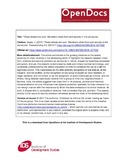‘These Streets Are Ours’: Mumbai’s Urban Form and Security in the Vernacular
| dc.contributor.author | Gupte, Jaideep | |
| dc.coverage.spatial | India | en |
| dc.date.accessioned | 2018-07-16T10:27:54Z | |
| dc.date.available | 2018-07-16T10:27:54Z | |
| dc.date.issued | 2017-02-16 | |
| dc.identifier.citation | Gupte, J. (2017) ‘These Streets Are Ours’: Mumbai’s Urban Form and Security in the Vernacular, Peacebuilding 5.2: 203-217 | en |
| dc.identifier.uri | https://opendocs.ids.ac.uk/opendocs/handle/20.500.12413/13894 | |
| dc.description.abstract | This article contributes to the growing literature on the spatial dynamics of urban violence in the developing world. It highlights the dialectic between urban form, violence and security provision as vernacular in nature, shaped by hyperlocal processes and actors. And yet, this dialectic is dominated by state and military-centred terminology, and continually underpinned by the state’s imposition of order to constitute the city as a site for legitimate control. This materialises as the often arbitrary recognition of one area as ‘at the margins’, and not another, as the recognition of one group of people as ‘slum dwellers’ or illegal residents, and not others, or as the recognition of some individuals as criminal, and not others. Using detailed case study material from a group of inner-city neighbourhoods in Mumbai, India, the article suggests that urban form in its physical, political and historical characterisations not only influences how vigilante protection operates, but also interacts in a non-benign manner with the mechanics by which the state endeavours to control violence. As such, it shapes who is vulnerable to violence, how vulnerable they are, and why. This speaks directly to the nature of security provision witnessed across the cities of the developing world. | en |
| dc.language.iso | en | en |
| dc.publisher | Taylor & Francis Group | en |
| dc.rights | © 2017 The author(s). Published by Informa UK limited, trading as Taylor & Francis group. This is an Open access article distributed under the terms of the Creative Commons attribution-noncommercial-noderivatives license (http://creativecommons.org/licenses/by-nc-nd/4.0/), which permits non-commercial re-use, distribution, and reproduction in any medium, provided the original work is properly cited, and is not altered, transformed, or built upon in any way. | en |
| dc.rights.uri | http://creativecommons.org/licenses/by-nc-nd/4.0/ | en |
| dc.subject | Security and Conflict | en |
| dc.title | ‘These Streets Are Ours’: Mumbai’s Urban Form and Security in the Vernacular | en |
| dc.type | Article | en |
| dc.rights.holder | Jaideep Gupte | en |
| dc.identifier.externaluri | https://www.tandfonline.com/doi/full/10.1080/21647259.2016.1277022 | en |
| dc.identifier.team | Conflict | en |
| dc.identifier.doi | 10.1080/21647259.2016.1277022 | |
| dcterms.dateAccepted | 2017-02-13 | |
| rioxxterms.funder | Default funder | en |
| rioxxterms.identifier.project | Default project | en |
| rioxxterms.version | AM | en |
| rioxxterms.versionofrecord | 10.1080/21647259.2016.1277022 | en |
| rioxxterms.funder.project | 9ce4e4dc-26e9-4d78-96e9-15e4dcac0642 | en |
Files in this item
This item appears in the following Collection(s)
Except where otherwise noted, this item's license is described as © 2017 The author(s). Published by Informa UK limited, trading as Taylor & Francis group. This is an Open access article distributed under the terms of the Creative Commons attribution-noncommercial-noderivatives license
(http://creativecommons.org/licenses/by-nc-nd/4.0/), which permits non-commercial re-use, distribution, and reproduction in any medium, provided the original work is properly cited, and is not altered, transformed, or built upon in any way.


